SLP Praxis (SLP)
Liberty University
Page 2 out of 42 results
Sort by
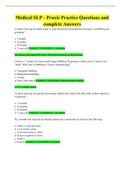
-
Medical SLP - Praxis Practice Questions and complete Answers
- Exam (elaborations) • 24 pages • 2023
-
- $11.99
- + learn more
Medical SLP - Praxis Practice Questions and complete Answers At about what age do infants begin to send intentional and purposeful messages via babbling and gesturing? Tommy is 7 months old and recently began babbling. He produces chains such as "mama" and "dada". What type of babbling is Tommy demonstrating? At about what age do typically developing children have about 200-300 words in their expressive vocabulary? By 3 months old, typically developing infants may consistently ...
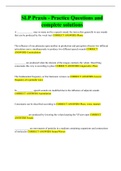
-
SLP Praxis - Practice Questions and complete solutions
- Exam (elaborations) • 15 pages • 2023
-
- $13.49
- + learn more
SLP Praxis - Practice Questions and complete solutions A _____________ may or many not be a speech sound; the term refers generally to any sounds that can be produced by the vocal tract The influence of one phoneme upon another in production and perception wherein two different articulators move simultaneously to produce two different speech sounds _________ are produced when the dorsum of the tongue contracts the velum. Describing consonants this way is according to place The fundament...
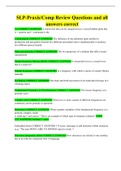
-
SLP-Praxis/Comp Review Questions and all answers correct
- Exam (elaborations) • 41 pages • 2023
-
- $17.19
- + learn more
SLP-Praxis/Comp Review Questions and all answers correct A semivowel that can be categorized as a voiced bilabial glide that is + anterior and + continuant is the The influence of one phoneme upon another in production and perception wherein two different articulators move simultaneously to produce two different speech sounds The two properties of a medium that affect sound transmission A sinusoidal wave is a sound wave that is a result of? Is a frequency with which a source of soun...
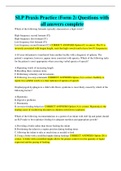
-
SLP Praxis Practice (Form 2) Questions with all answers complete
- Exam (elaborations) • 40 pages • 2023
-
- $15.99
- + learn more
SLP Praxis Practice (Form 2) Questions with all answers complete Which of the following formants typically characterizes a high vowel? A 65-year-old patient is transferred from another facility with a diagnosis of aphasia. The patient's symptoms, however, appear more consistent with apraxia. Which of the following tasks for the patient is most appropriate when assessing verbal apraxia of speech? . Oropharyngeal dysphagia in a child with Down syndrome is most likely caused by which o...
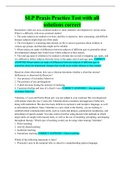
-
SLP Praxis Practice Test with all solutions correct
- Exam (elaborations) • 30 pages • 2023
-
- $13.99
- + learn more
SLP Praxis Practice Test with all solutions correct Researchers often use cross-sectional studies to study children's development in various areas. What is a difficulty with cross-sectional studies? . Based on client observation, how can a clinician determine whether a client has normal disfluencies or abnormal dysfluencies? Valentina, a 5-year-old Puerto Rican girl, was just added to your caseload. She was diagnosed with autism when she was 3 years old. Valentina shows resistance and a...
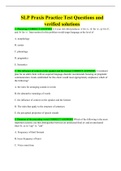
-
SLP Praxis Practice Test Questions and verified solutions
- Exam (elaborations) • 46 pages • 2023
-
- $14.99
- + learn more
SLP Praxis Practice Test Questions and verified solutions A 6 year old child produces /t/ for /s/, /d/ for /z/, /p/ for /f/, and /b/ for /v/. Intervention for this problem would target language at the level of A treatment plan for an adult client with an acquired language disorder recommends focusing on pragmatic communication. Goals established for this client would most appropriately emphasize which of the following? Which of the following is the most important acoustic cue that disting...
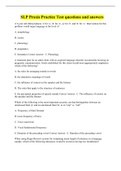
-
SLP Praxis Practice Test questions and answers
- Exam (elaborations) • 40 pages • 2022
-
Available in package deal
-
- $10.49
- + learn more
A 6 year old child produces /t/ for /s/, /d/ for /z/, /p/ for /f/, and /b/ for /v/. Intervention for this problem would target language at the level of A. morphology B. syntax C. phonology D. pragmatics E. Semantics Correct Answer: C. Phonology A treatment plan for an adult client with an acquired language disorder recommends focusing on pragmatic communication. Goals established for this client would most appropriately emphasize which of the following? A. the rules for arr...
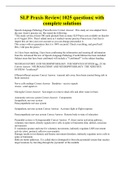
-
SLP Praxis Review| 1025 questions| with complete solutions
- Exam (elaborations) • 109 pages • 2022
-
Available in package deal
-
- $13.99
- 1x sold
- + learn more
Speech-Language Pathology Praxis Review Correct Answer: This study set was adapted from the user Anetz's practice set. She stated the following: "This study set has at least 500 cards gleaned from as many SLP Praxis sets available on Quizlet as of August 2016. Then I added more as I studied various practice Praxis tests. Feel free to import this set into your own account so you can change personalize it. This comes with no guarantees that it is 100% accurate! Check everything, and good luck...
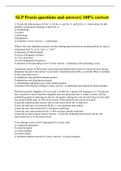
-
SLP Praxis questions and answers| 100% correct
- Exam (elaborations) • 22 pages • 2022
-
Available in package deal
-
- $12.49
- + learn more
A 6-year old child produces [t] for /s/, [d] for /z/, [p] for /f/, and [b] for /v/. Intervention for this problem would target language at the level of a) morphology b) syntax c) phonology d) pragmatics e) semantics Correct Answer: c) phonology What is the most important acoustic cue that distinguishes between an unreleased final /p/ and an unreleased final /b/, as in "cap" vs. "cab"? a) frequency of third formant b) locus of frequency of burst c) voice onset time d) vocal funda...
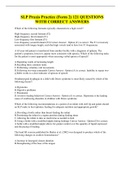
-
SLP Praxis Practice (Form 2) 121 QUESTIONS WITH CORRECT ANSWERS
- Exam (elaborations) • 35 pages • 2022
-
Available in package deal
-
- $10.49
- + learn more
Which of the following formants typically characterizes a high vowel? High-frequency second formant (F2) High-frequency first formant (F1) Low-frequency first formant (F1) Low-frequency second formant (F2) Correct Answer: Option (C) is correct. The F1 is inversely associated with tongue height, such that high vowels tend to have low F1 frequencies. A 65-year-old patient is transferred from another facility with a diagnosis of aphasia. The patient's symptoms, however, appear more consi...

$6.50 for your textbook summary multiplied by 100 fellow students... Do the math: that's a lot of money! Don't be a thief of your own wallet and start uploading yours now. Discover all about earning on Stuvia


